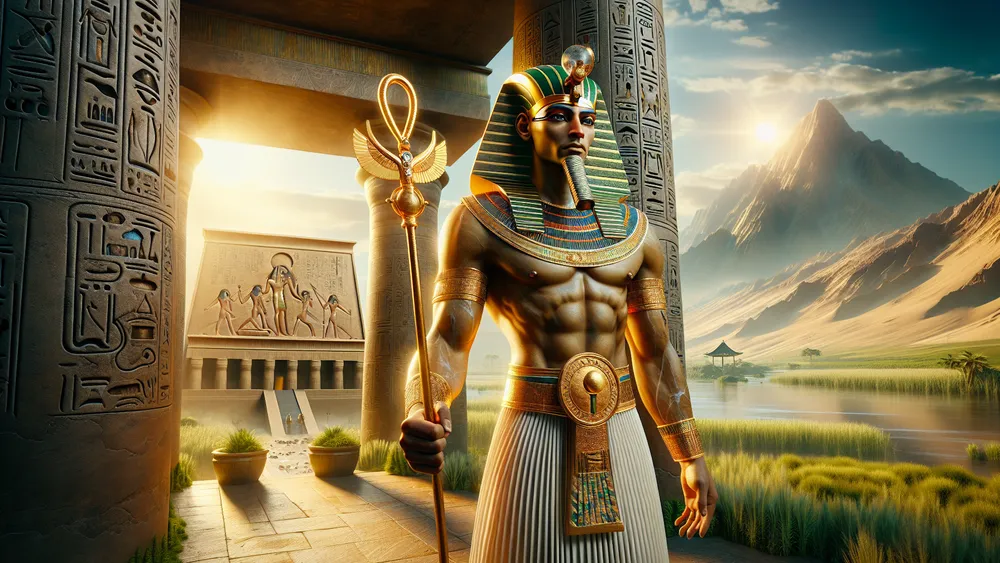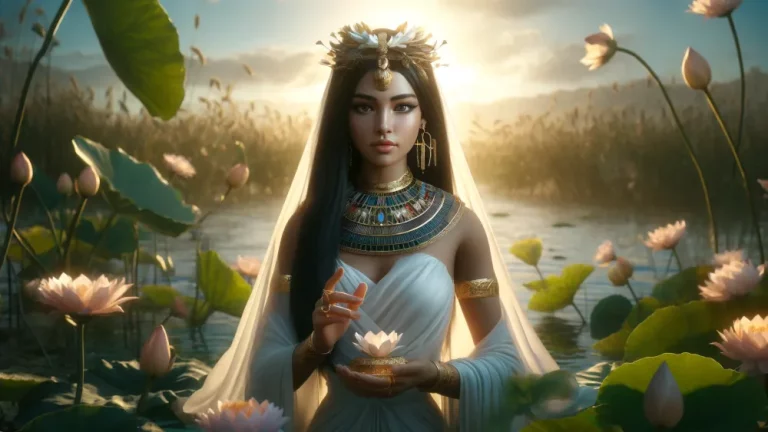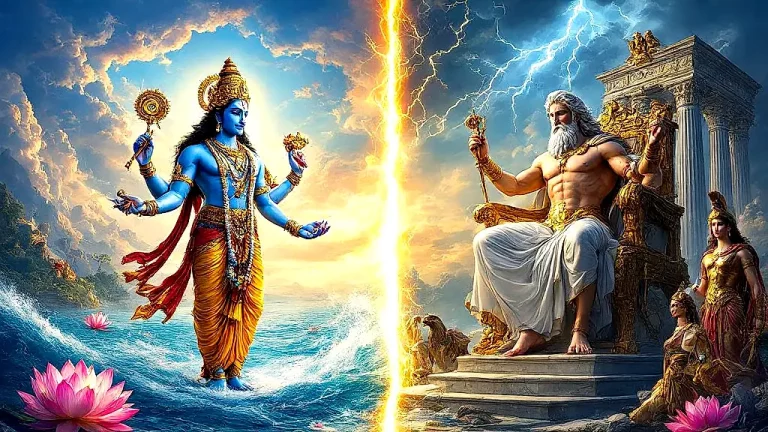Weneg: Egyptian Deity And Protector Of Earth
Weneg: Overview and Key Facts
This blog post covers Weneg, who is an old Egyptian god. We will look at Weneg. It is a god linked to Egypt mythology, history, and also culture.
Key Points:
- Weneg is an Egyptian deity linked to Earth, plants, and fertility, protecting crops.
- He is thought to be a son of Ra, the sun god, and played a role in maintaining cosmic balance.
- Weneg’s worship involved rituals for fertility, growth, and safety, influencing Egyptian leaders and gods.
- He was prominent during the Early Dynastic Period, particularly the Second Dynasty.
- Weneg’s symbols include the sky pillar, plants, and possibly the ankh.
- His influence extended to monumental architecture, agricultural advancements, and religious reforms in ancient Egypt.
- Weneg’s role as a mediator and protector in Egyptian mythology emphasized balance and order in the universe.
| Key Point | Description |
|---|---|
| Name | Weneg (people also call him Weneg-Nebty) |
| Role | God, protector of Earth, linked to plants and being fertile |
| Time Frame | Early Dynastic Period, mainly the Second Dynasty |
| Parentage | Often thought to be a son of Ra, who is the sun god |
| Symbols | Sky pillar, plants, maybe the ankh |
| Biggest Stories | Mediator among gods, linked to Ra’s soul |
| Worship | Rituals and events about fertility, growth, and keeping safe |
| Cultural Impact | Affected later Egyptian leaders and gods, very important in Egyptian stories |
| Archaeological Evidence | Limited but some writings and mentions in old texts |
| Temples and Priests | Worship had special temples, priests did the rituals |
Getting to Know Weneg
Let us look at what Weneg is, what makes him important in history, and the main things that show this god.
Who is Weneg?
Weneg, called Weneg-Nebty too, is a significant god but not well-known in old Egyptian myths. He is seen as protecting the Earth and linked with plants and being fertile, and he helps crops grow and be good. He is a god with ties to other gods, important ones like Ra, who is the sun god, and sometimes Ra’s son. Additionally, this tie shows he is important among Egypt’s gods. Here are some main things and symbols linked to him:
- Pillar of the Sky: He helps hold up the sky.
- Plants and Vegetation: Shows he is about fertility and growth.
- Possibly the Ankh: A life symbol, which matches his protecting and nurturing sides.
Weneg, a lesser-known Egyptian god, symbolizes fertility and growth through his association with plants, the sky, and the Ankh symbol.
The History of Weneg
The praise of Weneg can be found in the Early Dynastic Period of old Egypt, specifically during the Second Dynasty. His importance grew. He became linked with protecting the Earth and good crop growth, which were really important parts of old Egyptian life. Over time, Weneg started to do more things and was honored not only as a protector but also as a mediator among the gods. This historical timeline shows key times in Weneg’s praise:
- Early Dynastic Period (c. 2890–2686 BCE): First praise and recognition of Weneg as a god.
- Old Kingdom (c. 2686–2181 BCE): Weneg’s link with other major gods, especially Ra.
- Middle Kingdom (c. 2055–1650 BCE): Continued praise and getting into broader Egyptian myths.
The origins of Weneg in old Egyptian culture are deeply found in the society’s farming practices and their honor for natural things. As a god linked with plants and fertility, Weneg was crucial in ensuring crops grew well, which directly affected the people’s well-being. His link to Ra, the sun god, underlined his importance, as the sun was crucial for plant growth. To understand Weneg’s attributes compared to other Egyptian gods, look at this table:
| Deity | Role/Importance | Key Attributes/Symbols |
|---|---|---|
| Weneg | Earth protector, fertility god | Pillar of the Sky, plants, ankh |
| Ra | Sun god, creator | Sun disk, falcon, solar boat |
| Osiris | Afterlife god, resurrection | Crook and flail, white crown |
| Hathor | Love goddess, motherhood | Cow, sistrum, horns and sun disk |
This table shows how Weneg’s attributes align with his role in Egyptian myths, making him different from other gods while also showing his links in the pantheon.
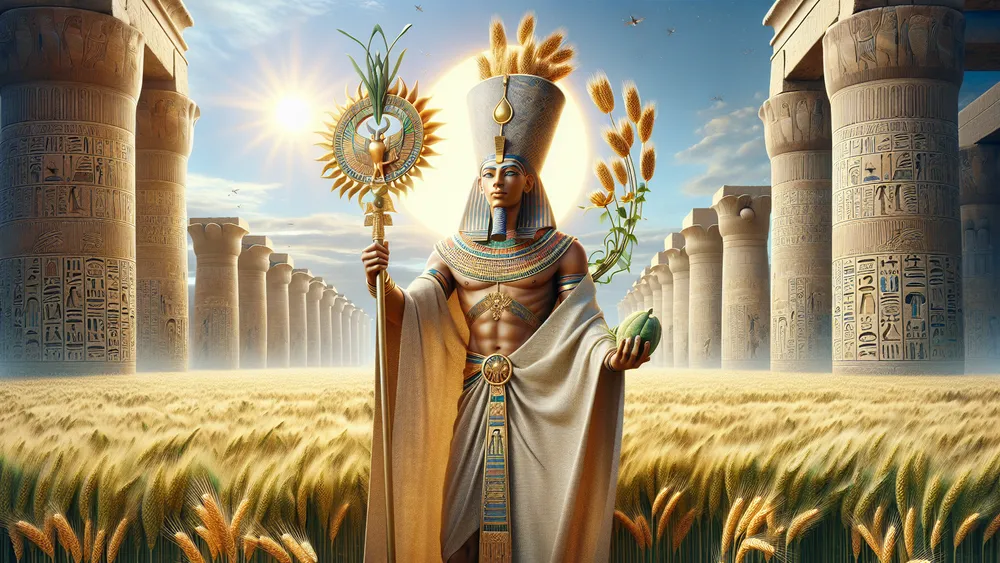
Weneg as a Pharaoh
Now, let’s look at Weneg’s time as a king and see what he did, in ancient Egyptian society, and how he mattered.
Weneg’s Rule and Accomplishments
Weneg’s time as a king is an interesting part of old Egypt’s history. Even though not many know him like those after him, Weneg’s rule was known for big achievements and helped make his kingdom stable and rich.
He is thought to have been king during the Second Dynasty, a time when power came together and system of administration began that would last a long time. Weneg did much, he started building big structures and pushed for better farming, both of which were very important for keeping up with the growing number of people.
Moreover, he made religious places stronger, making the king a political and spirit leader. Facts from old writings and archaeological digs give us important details about Weneg’s work for Egypt. Inscriptions and objects found in places like the necropolis of Saqqara show evidence of his projects and administrative changes. These finds point to Weneg’s work to make his kingdom’s infrastructure better and manage it well.
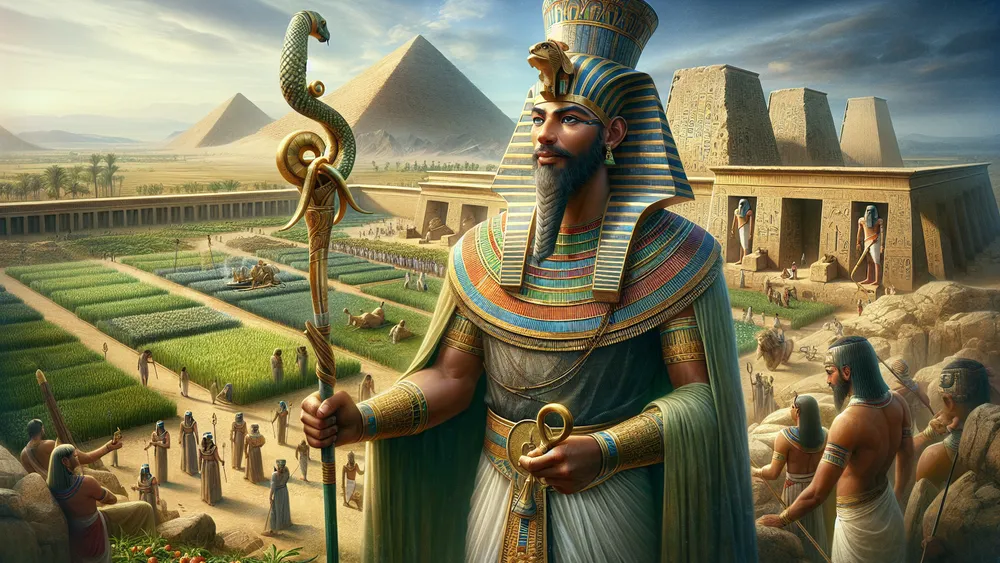
For better understanding, think about these important things Weneg did for Egyptian society and culture:
- Monumental Architecture: He started making big buildings like temples and places of administration.
- Agricultural Advancements: He pushed techniques that made crops grow better.
- Religious Reforms: He made religious places part of government.
- Administrative Systems: He made operations that later dynasties could use.
These achievements underline Weneg’s role in shaping the start of old Egypt, ensuring it grew and stayed stable for many generations.
The Influence and Impact of Weneg
People remember Weneg’s impact on later Egyptian rulers and gods, as he served as a model of god-like kingship and mixing religion with rule. He worked to make religious places strong and do better farming, and later kings did the same, making sure their reigns were stable and rich. Weneg’s link with fertility and Earth protection also connected with later gods, who took on similar roles and features.
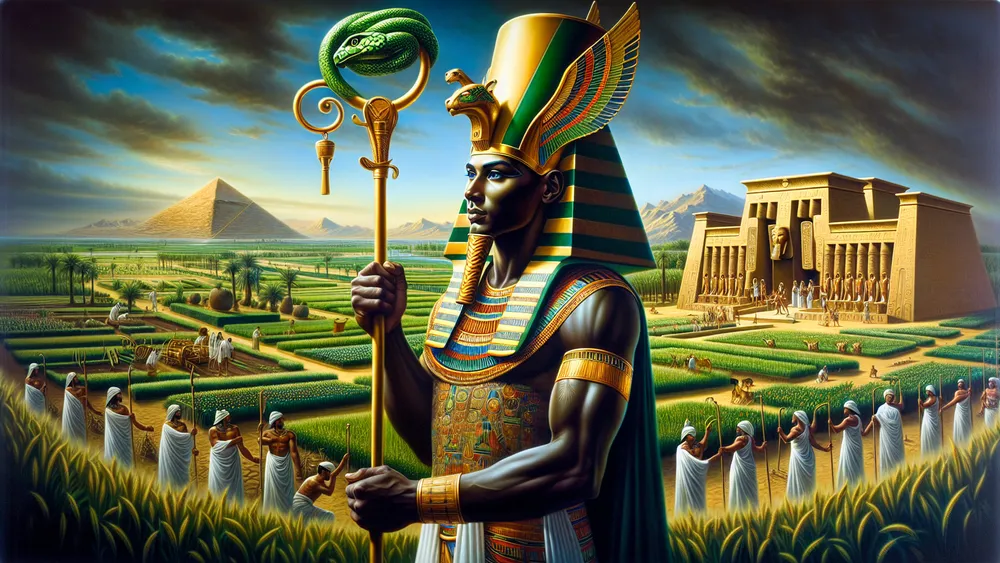
For example, the god Osiris, who became very important in Egyptian myths, shares Weneg’s connection to fertility and the afterlife. Weneg’s lasting effect on Egyptian myths and culture is clear in the ongoing respect for gods linked to vegetation and the Earth, as well as the ongoing importance of the king’s role as both a political and religious leader.
This double role, first shown by Weneg, became a key part of old Egyptian civilization, shaping its growth for thousands of years.
Weneg in Egyptian Stories and Legends
We will look at interesting Weneg’s stories and roles in Egyptian mythology, showing him as a go-between among gods. Moreover, in other stories, he did even more.
Weneg as a Mediator Among the Gods
In Egyptian stories, Weneg is often shown as a go-between for gods, a role that shows his meaning in keeping cosmic balance. There is one story that shows Weneg stepping in to settle fights between gods to bring back peace and order. For instance, in a story where gods Horus and Set argue over who should take Egypt’s throne, Weneg steps in to mediate and keep the divine order.
This role is much like a skilled diplomat who brings peace between fighting nations, showing Weneg’s wisdom and fairness. By being a go-between, Weneg not only solves fights but also helps keep both the divine and human worlds together, stressing why peace matters in both.
This part of Weneg’s stories shows the broader belief in Ma’at, the idea of truth, balance, and order, which was key to how Egyptians saw the world.
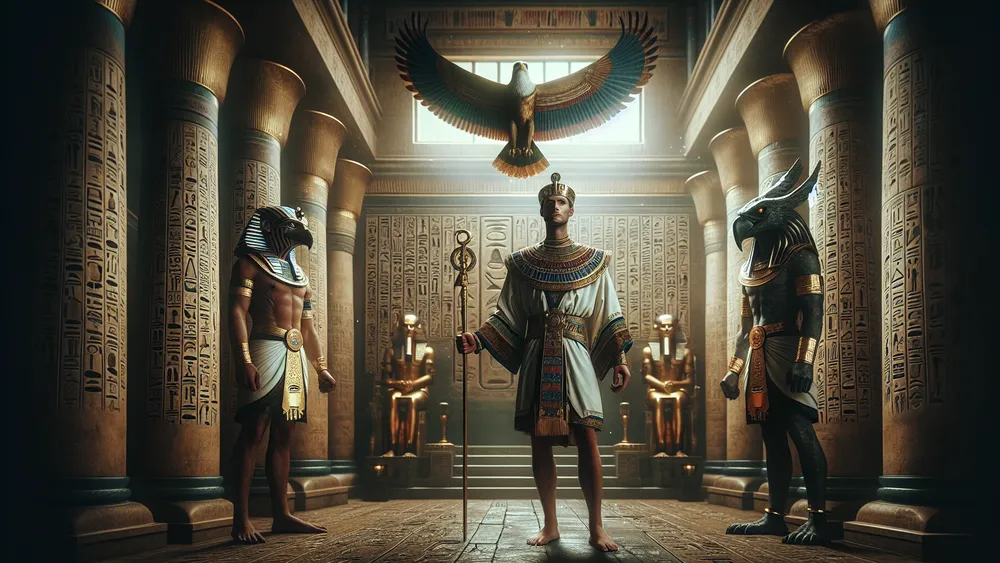
Weneg and the Sky Pillar
Weneg’s link to the Sky Pillar is an important part of his role in Egyptian stories, showing his job as a force that keeps the world steady. The Sky Pillar is often shown as a huge column that holds up the heavens, showing the connection between earth and the godly world.
Weneg, a god tied to this pillar, works as a protector who makes sure the sky stays in place, stopping chaos from falling on the world below. His job can be compared to how a central pillar keeps a big building stable. In Egyptian tales, this symbol shows Weneg’s importance in keeping the universe balanced, connecting to the larger idea of Ma’at, which is about truth and order.
By linking Weneg to the Sky Pillar, the old Egyptians showed how important he was in maintaining the world’s structure, making sure both gods and people could live well in an orderly place.
Weneg’s connection to the Sky Pillar symbolizes his crucial role in maintaining balance and order in Egyptian mythology.
Weneg and the Soul of Ra
Weneg’s link to the sun god Ra is a deep part of who he is in Egyptian stories, often seen as the soul of Ra. This link shows Weneg’s important job of holding Ra’s life force and godly essence, just like how a soul is the life spark inside a living being.
In tales, Weneg being the soul of Ra means he carries the power of the sun god inside him, and he is a way for Ra’s godly energy. Moreover, the way a lighthouse channels a bright beacon’s light, guiding and lighting the path for others.
The mythological meaning of this link shows Weneg’s meaning in keeping the world in order and making sure the day and night cycle keeps going, which is key to how Egyptians saw the universe. Because of being the soul of Ra, Weneg plays a key role in keeping the balance and order needed in both divine and human worlds.
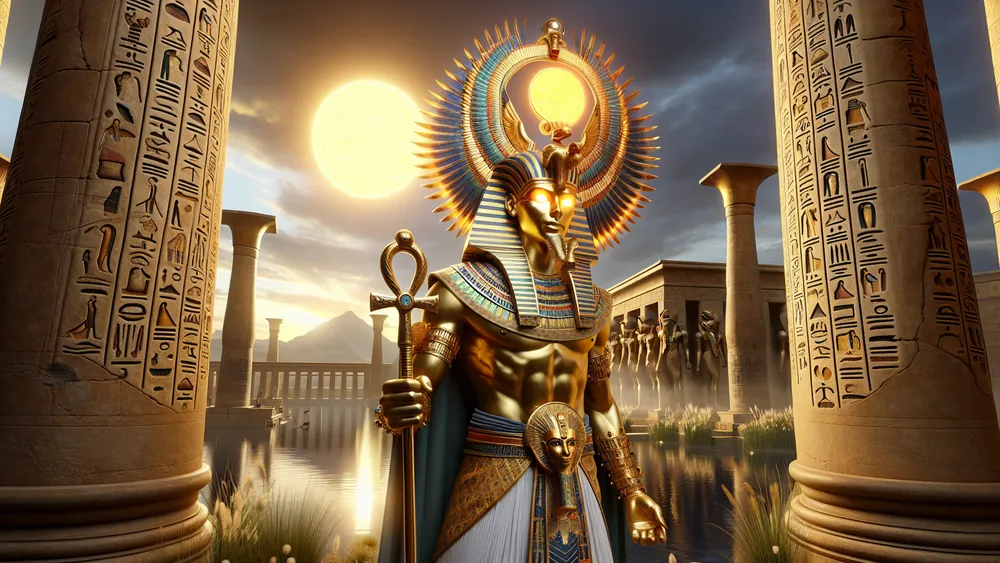
Weneg as the God of Plants
Now, we look into Weneg’s job as the plant god and how he affected farming and plants in old Egypt.
Weneg’s Role as a Plant God
Weneg’s link with plants shows his important job in old Egypt’s farming and nature. Weneg, a god tied to growth, watched over crops’ well-being, making the land stay fertile with lots of crops. Moreover, specific plants and farming methods linked to Weneg include wheat, barley, and growing of papyrus. Very crucial. Essential to the Egyptian economy and daily lives.
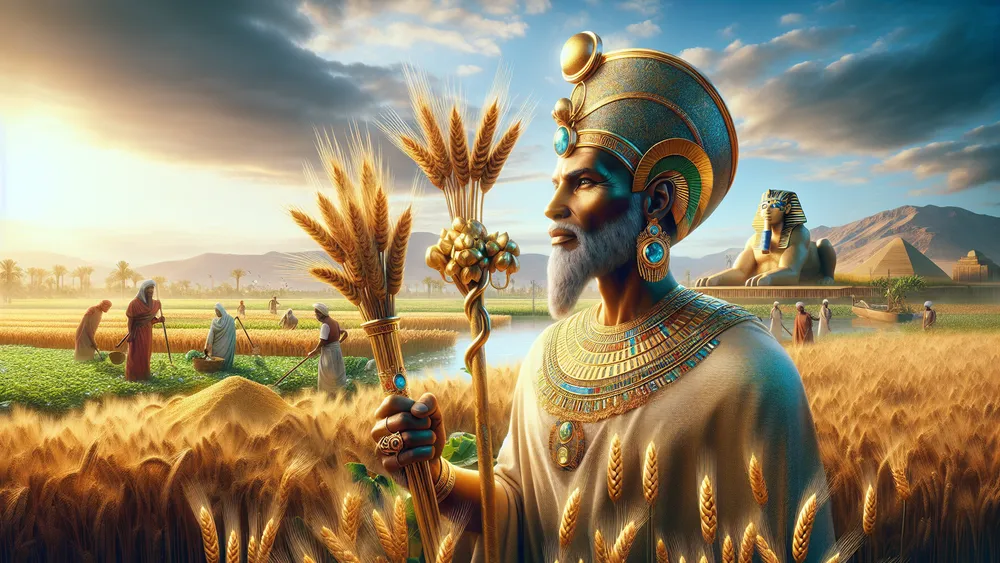
Farmers would seek Weneg’s blessings at planting and harvest time, wanting his favor for good crops. Then, like a gardener who carefully looks after plants, Weneg made sure they got what they needed to grow well. Weneg’s importance in making sure plants grew well shows the old Egyptians’ need for gods in farming, showing their strong connection to the land and its cycles.
They knew keeping balance was key for life and honored Weneg for this. So they saw the balance needed to keep everything going.
- Wheat
- Barley
- Papyrus growing
Rituals and How People Worshipped Weneg
Events for Weneg were a vital part of old Egypt’s religion, which showed how much people respected this god. These events often had food, drink, and incense, and people believed these would please Weneg. Also, events included reading hymns and prayers asking for Weneg’s help and blessings for growth.
During planting time, farmers did special acts to make sure they got good crops, just like how people today follow steps for good planting results. These acts were more than respect; they were useful steps to stay in line with the strong forces in nature. Moreover, priests and temples were very important in worship of Weneg.
Temples for Weneg had statues and holy objects linked to the god, becoming main places for worship and community events. Priests did daily acts to honor Weneg, kept the temple in good condition, and made sure people always noticed the god. They also led big festivals and public events, guiding the people in shared acts of worship.
This is similar to how today’s religious leaders help people worship and take care of holy places, meeting the community’s spiritual needs. By honoring Weneg through these set practices, old Egyptians wanted to keep balance and order in farming and in their wider relationship with the gods.
The Egyptian Gods and Goddesses
The group of Egyptian gods and goddesses is big and different, which showed the deep and complicated religious life of old Egypt. Each god had roles and traits, and they added to the balance and harmony in the universe. Moreover, Ra the sun god was powerful, and Weneg was a protective god. They were important in every part of life, from farming to life after death.
If you want to see all these interesting gods, check out this complete list of all the Egyptian gods, which gives a complete look at their roles and meaning in Egyptian stories.
FAQs
1. Who were Weneg’s parents in Egyptian mythology?
Weneg’s parents in Egyptian mythology are typically identified as Geb, the earth god, and Nut, the sky goddess.
2. How is Weneg depicted in ancient Egyptian art?
Weneg is depicted in ancient Egyptian art typically as a man wearing the double crown of Upper and Lower Egypt, often holding a scepter and an ankh.
3. What are the main symbols associated with Weneg?
The main symbols associated with Weneg include the sky pillar and various plant motifs, reflecting his roles in Egyptian mythology.
4. How did Weneg’s worship influence later Egyptian religious practices?
Weneg’s worship influenced later Egyptian religious practices by integrating his attributes into the rituals and iconography of subsequent deities.

